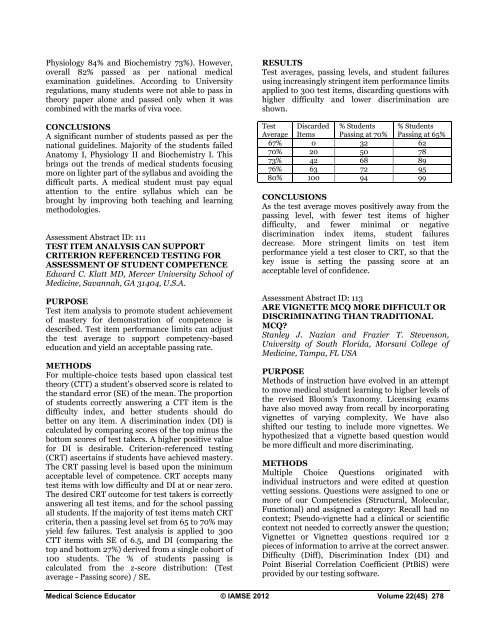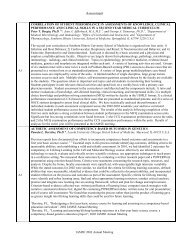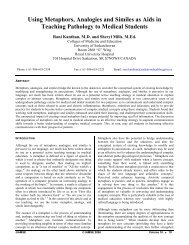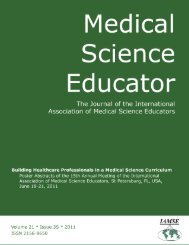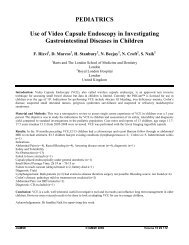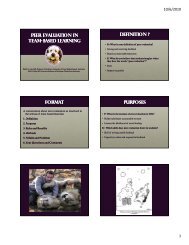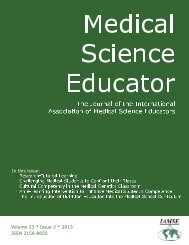Click here to view complete journal in pdf-format - IAMSE
Click here to view complete journal in pdf-format - IAMSE
Click here to view complete journal in pdf-format - IAMSE
You also want an ePaper? Increase the reach of your titles
YUMPU automatically turns print PDFs into web optimized ePapers that Google loves.
Physiology 84% and Biochemistry 73%). However,<br />
overall 82% passed as per national medical<br />
exam<strong>in</strong>ation guidel<strong>in</strong>es. Accord<strong>in</strong>g <strong>to</strong> University<br />
regulations, many students were not able <strong>to</strong> pass <strong>in</strong><br />
theory paper alone and passed only when it was<br />
comb<strong>in</strong>ed with the marks of viva voce.<br />
CONCLUSIONS<br />
A significant number of students passed as per the<br />
national guidel<strong>in</strong>es. Majority of the students failed<br />
Ana<strong>to</strong>my I, Physiology II and Biochemistry I. This<br />
br<strong>in</strong>gs out the trends of medical students focus<strong>in</strong>g<br />
more on lighter part of the syllabus and avoid<strong>in</strong>g the<br />
difficult parts. A medical student must pay equal<br />
attention <strong>to</strong> the entire syllabus which can be<br />
brought by improv<strong>in</strong>g both teach<strong>in</strong>g and learn<strong>in</strong>g<br />
methodologies.<br />
Assessment Abstract ID: 111<br />
TEST ITEM ANALYSIS CAN SUPPORT<br />
CRITERION REFERENCED TESTING FOR<br />
ASSESSMENT OF STUDENT COMPETENCE<br />
Edward C. Klatt MD, Mercer University School of<br />
Medic<strong>in</strong>e, Savannah, GA 31404, U.S.A.<br />
PURPOSE<br />
Test item analysis <strong>to</strong> promote student achievement<br />
of mastery for demonstration of competence is<br />
described. Test item performance limits can adjust<br />
the test average <strong>to</strong> support competency-based<br />
education and yield an acceptable pass<strong>in</strong>g rate.<br />
METHODS<br />
For multiple-choice tests based upon classical test<br />
theory (CTT) a student’s observed score is related <strong>to</strong><br />
the standard error (SE) of the mean. The proportion<br />
of students correctly answer<strong>in</strong>g a CTT item is the<br />
difficulty <strong>in</strong>dex, and better students should do<br />
better on any item. A discrim<strong>in</strong>ation <strong>in</strong>dex (DI) is<br />
calculated by compar<strong>in</strong>g scores of the <strong>to</strong>p m<strong>in</strong>us the<br />
bot<strong>to</strong>m scores of test takers. A higher positive value<br />
for DI is desirable. Criterion-referenced test<strong>in</strong>g<br />
(CRT) ascerta<strong>in</strong>s if students have achieved mastery.<br />
The CRT pass<strong>in</strong>g level is based upon the m<strong>in</strong>imum<br />
acceptable level of competence. CRT accepts many<br />
test items with low difficulty and DI at or near zero.<br />
The desired CRT outcome for test takers is correctly<br />
answer<strong>in</strong>g all test items, and for the school pass<strong>in</strong>g<br />
all students. If the majority of test items match CRT<br />
criteria, then a pass<strong>in</strong>g level set from 65 <strong>to</strong> 70% may<br />
yield few failures. Test analysis is applied <strong>to</strong> 300<br />
CTT items with SE of 6.5, and DI (compar<strong>in</strong>g the<br />
<strong>to</strong>p and bot<strong>to</strong>m 27%) derived from a s<strong>in</strong>gle cohort of<br />
100 students. The % of students pass<strong>in</strong>g is<br />
calculated from the z-score distribution: (Test<br />
average - Pass<strong>in</strong>g score) / SE.<br />
RESULTS<br />
Test averages, pass<strong>in</strong>g levels, and student failures<br />
us<strong>in</strong>g <strong>in</strong>creas<strong>in</strong>gly str<strong>in</strong>gent item performance limits<br />
applied <strong>to</strong> 300 test items, discard<strong>in</strong>g questions with<br />
higher difficulty and lower discrim<strong>in</strong>ation are<br />
shown.<br />
Test<br />
Average<br />
Discarded<br />
Items<br />
% Students<br />
Pass<strong>in</strong>g at 70%<br />
% Students<br />
Pass<strong>in</strong>g at 65%<br />
67% 0 32 62<br />
70% 20 50 78<br />
73% 42 68 89<br />
76% 63 72 95<br />
80% 100 94 99<br />
CONCLUSIONS<br />
As the test average moves positively away from the<br />
pass<strong>in</strong>g level, with fewer test items of higher<br />
difficulty, and fewer m<strong>in</strong>imal or negative<br />
discrim<strong>in</strong>ation <strong>in</strong>dex items, student failures<br />
decrease. More str<strong>in</strong>gent limits on test item<br />
performance yield a test closer <strong>to</strong> CRT, so that the<br />
key issue is sett<strong>in</strong>g the pass<strong>in</strong>g score at an<br />
acceptable level of confidence.<br />
Assessment Abstract ID: 113<br />
ARE VIGNETTE MCQ MORE DIFFICULT OR<br />
DISCRIMINATING THAN TRADITIONAL<br />
MCQ?<br />
Stanley J. Nazian and Frazier T. Stevenson,<br />
University of South Florida, Morsani College of<br />
Medic<strong>in</strong>e, Tampa, FL USA<br />
PURPOSE<br />
Methods of <strong>in</strong>struction have evolved <strong>in</strong> an attempt<br />
<strong>to</strong> move medical student learn<strong>in</strong>g <strong>to</strong> higher levels of<br />
the revised Bloom’s Taxonomy. Licens<strong>in</strong>g exams<br />
have also moved away from recall by <strong>in</strong>corporat<strong>in</strong>g<br />
vignettes of vary<strong>in</strong>g complexity. We have also<br />
shifted our test<strong>in</strong>g <strong>to</strong> <strong>in</strong>clude more vignettes. We<br />
hypothesized that a vignette based question would<br />
be more difficult and more discrim<strong>in</strong>at<strong>in</strong>g.<br />
METHODS<br />
Multiple Choice Questions orig<strong>in</strong>ated with<br />
<strong>in</strong>dividual <strong>in</strong>struc<strong>to</strong>rs and were edited at question<br />
vett<strong>in</strong>g sessions. Questions were assigned <strong>to</strong> one or<br />
more of our Competencies (Structural, Molecular,<br />
Functional) and assigned a category: Recall had no<br />
context; Pseudo-vignette had a cl<strong>in</strong>ical or scientific<br />
context not needed <strong>to</strong> correctly answer the question;<br />
Vignette1 or Vignette2 questions required 1or 2<br />
pieces of <strong>in</strong><strong>format</strong>ion <strong>to</strong> arrive at the correct answer.<br />
Difficulty (Diff), Discrim<strong>in</strong>ation Index (DI) and<br />
Po<strong>in</strong>t Biserial Correlation Coefficient (PtBiS) were<br />
provided by our test<strong>in</strong>g software.<br />
Medical Science Educa<strong>to</strong>r © <strong>IAMSE</strong> 2012 Volume 22(4S) 278


